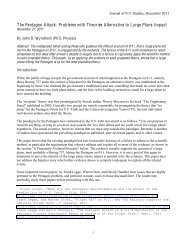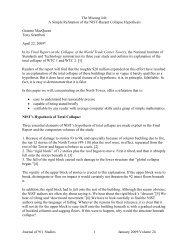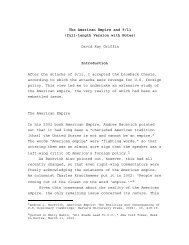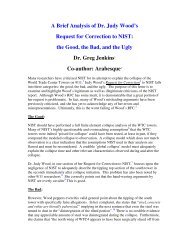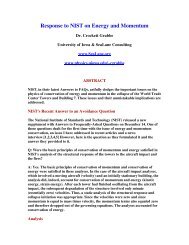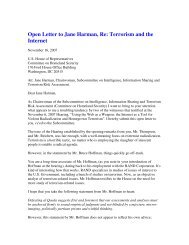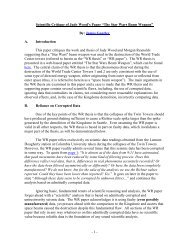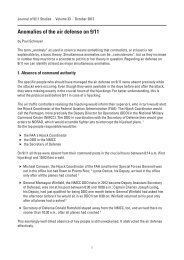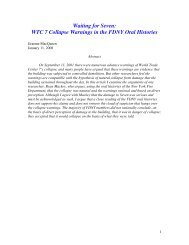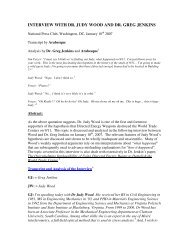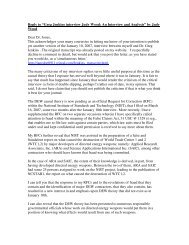<strong>Journal</strong> <strong>of</strong> 9/<strong>11</strong> <strong>Studies</strong> Volume 34, November 2012The times put forward by the 9/<strong>11</strong> Commission come from radar at ground level and arebased on the National Transportation Safety Board (NTSB) and Federal AviationAdministration (FAA) data. They are the only reliable times because they are based onground radar data which do not involve any hypothetical assumptions. They areconsidered to be reliable to one second.For the time <strong>of</strong> the impact <strong>of</strong> the plane into WTC1 furnished by the Commission, 8.46.40(9/<strong>11</strong> Commission Report, p. 7; Ritter, 2002), there is a hiatus <strong>of</strong> 15 seconds between theplausible time <strong>of</strong> the origin <strong>of</strong> the Rayleigh wave based on the Palisades data and thetime -- afterwards -- <strong>of</strong> the crash <strong>of</strong> the plane into WTC1 based on the ground radar data.What else but an explosion could be the origin for this seismic wave in the absence <strong>of</strong> anearthquake? A similar discrepancy exists in the data for the seismic wave and impacttimes for WTC2.Also, the crash <strong>of</strong> the plane into WTC2 cannot be the cause for a camera, solidly on theground and probably mounted to a tripod, which is filming WTC1 (see 9<strong>11</strong>Blogger.com,2006) to strongly shake one second before the fireball following this impact and shakeagain five seconds later: Only strong explosions can cause such shaking. This has beendiscussed at length by MacQueen (<strong>Journal</strong> <strong>of</strong> 9/<strong>11</strong> <strong>Studies</strong>, 2009)SEISMIC WAVE-GENERATION FROM IMPACTS, COLLAPSES ANDEXPLOSIONSAttributing the transformation <strong>of</strong> kinetic energy into seismic waves to the crash <strong>of</strong> a jetinto a building would make sense only if such a crash involved two full, solid and nondeformableobjects. In this case, the kinetic energy <strong>of</strong> the moving body would in part betransformed into heat and the rest would be transmitted to the stricken object in the form<strong>of</strong> vibrations, that is, seismic waves. However, that is not the case here because we havetwo hollow and deformable objects. During the crash, the whole <strong>of</strong> the energy istransformed into heat and the envelopes (exterior walls) are deformed. In the case wherea little mechanical energy would remain, the waves created in the pierced envelope wouldbe quickly dispersed because <strong>of</strong> the absence <strong>of</strong> continuity in this envelope due to thespaces between vertical and horizontal structural members, such as rooms and windows.The necessary condition for the creation <strong>of</strong> seismic waves by such a crash would be thedirect impact into the central columns by a full body. Even if a Boeing engine had hit acore column, it would have been with an energy lessened by passage through thebuilding's envelope. In conclusion, even if a seismic wave could be created in a steelcolumn, it would hit the ground only in the form <strong>of</strong> seismic noise, and as the passagefrom metal to rock is a refraction that absorbs energy, there would not be much left topropagate in the ground.Could the collapse <strong>of</strong> the Towers be the source <strong>of</strong> seismic waves as claimed by LDEOand other defenders <strong>of</strong> the <strong>of</strong>ficial account? The enormous mass <strong>of</strong> the Twin Towerscould hypothetically be taken into account if the Towers had fallen in a compact block,like a meteorite. But in fact, it was mostly scattered shards, not coherent blocks, that fell,largely transformed into dust, and the fall spanned several seconds. This form <strong>of</strong> collapse6
<strong>Journal</strong> <strong>of</strong> 9/<strong>11</strong> <strong>Studies</strong> Volume 34, November 2012could only produce a force far below that necessary to create seismic waves; in this case,the magnitudes simply do not add up, and the result is a noise <strong>of</strong> various magnitudes andfrequencies.Given that neither the crashes into the towers, nor their vibration, nor the fall <strong>of</strong> debriscan be the source <strong>of</strong> the seismic waves registered 34 kilometres away, as well as the factthat the low frequencies <strong>of</strong> those waves could not have been generated by suchphenomena, we must search for the actual causes <strong>of</strong> the waveforms observed. Onlyexplosions could produce the waves observed but various possible explosiveconfigurations must be considered. We must distinguish between 1) subterraneanexplosions, 2) aerial explosions and 3) subaerial explosions (close to the ground withouttouching it).Subterranean explosions are similar to earthquakes in that mechanical energy istransmitted to the earth in the form <strong>of</strong> body waves <strong>of</strong> two types, P and S (for "primary"and "secondary," or "pressure" and "shear"), and surface waves (either Rayleigh ortransverse L) when the signal reaches a solid-fluid interface (for example, the atmosphereat the surface). Another name for Rayleigh waves is ground roll.Aerial explosions release all <strong>of</strong> their energy in the air (as P waves, which in theatmosphere are simply sound waves), and what remains upon hitting the ground is thustoo weak to create body waves in the solid earth (although there can be surface wavesover a small distance).Subaerial explosions give <strong>of</strong>f energy that splits into sound waves, mainly in the air, andsurface waves in the ground.EXPLOSIONS THE SOURCE OF 9/<strong>11</strong> SEISMIC WAVEFORMSA subterranean explosion might not be heard, but the ground would shake and initiate aseries <strong>of</strong> waves (body and surface waves). If we distinctly hear an explosion, it is eitheraerial, which does not give a seismic signal, or it is subaerial, in which case surfacewaves could be generated. The seismic wave data provided by Palisades prove theoccurrence <strong>of</strong> surface waves radiating outward from the World Trade Center. In addition,witnesses reported hearing explosions very close to the times at which planes struck theTowers and when they collapsed (see particularly MacQueen, 2006).Given these two types <strong>of</strong> evidence we can affirm that subaerial explosions occurred closeto the base <strong>of</strong> the Towers almost or quite simultaneously with the crashes into the Towersby the planes. The sound coming from these explosions would have been mixed with thesounds generated by the impacts <strong>of</strong> the planes. The explosion at the base <strong>of</strong> WTC1 washeard and reported by William Rodriquez (Spingola, 2005).The employees <strong>of</strong> the Secret Service, whose <strong>of</strong>fices were in WTC7 wholly separatedfrom WTC1, noticed this event: “On September <strong>11</strong>, like any other morning, most <strong>of</strong> theSecret Service employees were either settling into their <strong>of</strong>fices or still making their way7
- Page 1 and 2: Journal of 9/11 Studies Volume 34,
- Page 3 and 4: Journal of 9/11 Studies Volume 34,
- Page 8 and 9: Journal of 9/11 Studies Volume 34,
- Page 10 and 11: Journal of 9/11 Studies Volume 34,
- Page 12 and 13: Journal of 9/11 Studies Volume 34,
- Page 14 and 15: Journal of 9/11 Studies Volume 34,
- Page 16 and 17: Journal of 9/11 Studies Volume 34,
- Page 18 and 19: Journal of 9/11 Studies Volume 34,
- Page 20 and 21: Journal of 9/11 Studies Volume 34,
- Page 22 and 23: Journal of 9/11 Studies Volume 34,



